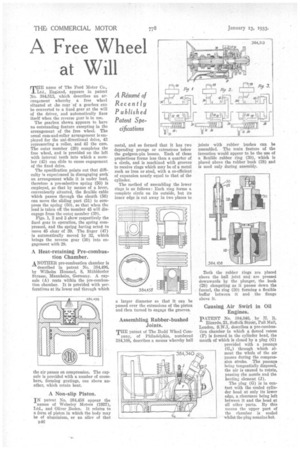A Free Wheel at Will
Page 60

If you've noticed an error in this article please click here to report it so we can fix it.
THE name of The Ford Motor Co., Ltd., Engiand, appears in patent No. 884,513, which describes an arrangement whereby a free wheel situated at the rear of a gearbox can be converted to a fixed gear at the will of the driver, and automatically fixes itself when the reverse gear is in use.
The gearbox shown appears to have no outstanding feature excepting in the arrangement of the free wheel. The usual cam-and-roller arrangement is employed for the uni-directional drive, 43 representing a roller, and 42 the cam.
The outer member (39) completes the free wheel, and is provided on the left with internal teeth into which a member (45) can slide to cause engagement of the fixed drive.
The specification points out that difficulty is experimeed in disengaging Such an arrangement while it is under load, therefore a pre-selective spring (50) is employed, so that by means of a lever, conveniently situated, the flexible cable which passes through the sheath (56) can move the sliding part (51) to com press the spring (50), so that when the load is taken off the member 45 will disengage from the outer member (39).
Figs. 1, 2 and 3 show respectively the fixed gear in operation, the spring com
pressed, and the spring having acted to move 45 clear of 39. The finger (47) is automatically moved by 32, which brings the reverse gear (30) into engagement with 29.
A Heat-retaining Pre-combustion Chamber.
ANOTHER pre-combustion chamber is
described in patent No. 384,496, by Wilhelm Hommel, 8, MilliModer Strasse, Mannheim, Germany. A capsule (A) rests within the pre-combustion chamber. It is provided with perforations at its lower end through which
the air passes on compression. The capsule is provided with a number of crossbars, forming gratings, one above another, which retain heat.
A Non-slip Piston.
IN patent No. 384,458 appear the names of Wolseley Motors (1927), Ltd., and Oliver )3oden. It relates to a form of piston in which the body may be of aluminium. or an alloy of that E413 metal, and so formed that it has two depending prongs or extensions below the gudgeon-pin bosses. Each of these projections forms less than a quarter of a circle, and is machined with grooves to receive rings which may be of a metal such as iron or steel, with a co-efficient of expansion nearly equal to that of the cylinder.
The method of assembling the lower rings is as follows: Each ring forms a complete circle on its outside, but its inner edge is cut away in two places to a larger diameter so that it can be passed over the extensions of the piston and then turned to engage the grooves.
Assembling Rubber-bushed Joints.
THE patent of The Budd Wheel Company, of Philadelphia, numbered 384,108, describes a means whereby ball joints with rubber bushes can be assembled. The main feature of the invention would appear to be the use of a flexible rubber ring (30), which is placed above the rubber bush (28) and is used only during assembly.
Both the rubber rings are placed above the ball joint and are pressed downwards by the plunger, the .bush (28) elongating as it passes down the funnel, the ring (30) forming a flexible buffer between it and the flange above it.
Causing Air Swirl in Oil Engines.
PATENT No. 384,340, by H. R. Ricardo, 21, Suffolk Street, Pall Mall, London, S.W.1, describes a pre-combustion chamber in which a domed recess (F) is formed in the cylinder head, the mouth of which is closed by a plug (G) provided with a passage
(GO through which almost the whole of the air Passes during the compression stroke. The passage being tangentially disposed, the air is caused to rotate, passing the nozzle and the heating element (J).
The plug (G) is in contact with the cooled cylinder head at only its lower edge, a,clearance being left between it and the head at all other parts. By this means the upper part of the chamber is cooled whilst the plug remains hot.




























































































